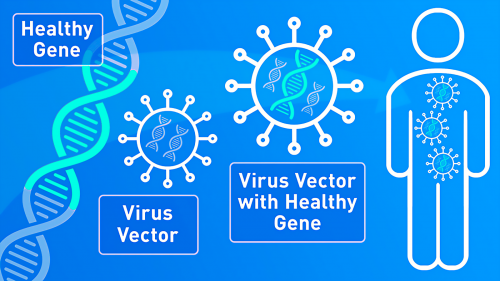Español
The genes in your body’s cells play a key role in your health. Indeed, a defective gene or genes can make you sick.
Recognizing this, scientists have worked for decades on ways to modify genes or replace faulty genes with healthy ones to treat, cure, or prevent a disease or medical condition.
This research is paying off, as advancements in science & technology today are changing the way we define disease, develop drugs, & prescribe treatments.
The U.S. Food & Drug Administration has approved multiple gene therapy products for cancer & rare disease indications.
Genes, Cells, & How They Interact
Genes & cells are intimately related. Within the cells of our bodies, there are thousands of genes that provide the information to produce specific proteins that help make up the cells. Cells are the basic building blocks of all living things; the human body is composed of trillions of them.
The genes provide the information that makes different cells do different things. Groups of many cells make up the tissues & organs of the body, including muscles, bones, & blood. The tissues & organs in turn support all our body’s functions.
How Gene Therapy Works
Sometimes the whole or part of a gene is defective or missing from birth. This is typically referred to as a genetically inherited mutation.
In addition, healthy genes can change (mutate) over the course of our lives. These acquired mutations can be caused by environmental exposures. The good news is that most of these genetic changes (mutations) do not cause disease. But some inherited & acquired mutations can cause developmental disorders, neurological diseases, & cancer.
Depending on what is wrong, scientists can do one of several things in gene therapy:
- They can replace a gene that is missing or is causing a problem.
- They can add genes to the body to help treat disease.
- Or they can turn off genes that are causing problems.
To insert new genes directly into cells, scientists use a vehicle called a “vector.” Vectors are genetically engineered to deliver the necessary genes for treating the disease.
Vectors need to be able to efficiently deliver genetic material into cells, & there are different kinds of vectors. Viruses are currently the most commonly used vectors in gene therapies because they have a natural ability to deliver genetic material into cells. Before a virus can be used to carry therapeutic genes into human cells, it is modified to remove its ability to cause infectious disease.
Gene therapy can be used to modify cells inside or outside the body. When a gene therapy is used to modify cells inside the body, a doctor will inject the vector carrying the gene directly into the patient.
When gene therapy is used to modify cells outside the body, doctors take blood, bone marrow, or another tissue, & separate out specific cell types in the lab. The vector containing the desired gene is introduced into these cells. The cells are later injected into the patient, where the new gene is used to produce the desired effect.
Safety & Effectiveness of Gene Therapy
Before a gene therapy can be marketed for use in humans, the product must be tested in clinical studies for safety & effectiveness so FDA scientists can consider whether the risks of the therapy are acceptable considering the potential benefits.
The scientific field for gene therapy products is fast-paced & rapidly evolving – ushering in a new approach to the treatment of vision loss, cancer, & other serious & rare diseases. As scientists continue to make great strides in this therapy, the FDA is committed to helping speed up development by interacting with those developing products & through prompt review of groundbreaking treatments that have the potential to save lives.
Source: FDA Consumer Updates

